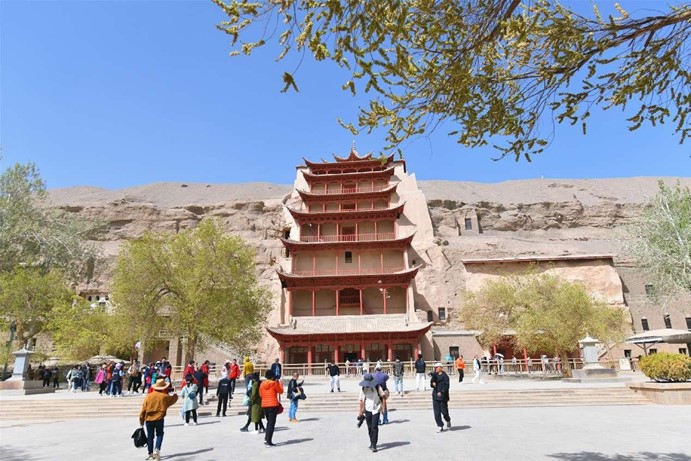Dunhuang Culture – A Bridge for Cultural Exchange.

27.10.2023
Su Bomin.
The Silk Road, also called as the “canal of human culture” and the “Eurasian artery”, passes through the city of Dunhuang (Gansu Province, Northwestern China) and connects four great ancient civilizations, namely the civilizations of China, Indus, Egypt and Sumer. The Dunhuang culture, represented by the Buddhist cave temples of Mogao and artifacts in the Cangjingdong Cave (sutra storage cave), has existed for almost 2,000 years. It is the result of the fusion and interaction of Chinese culture with Indian, Greek, Persian and other foreign cultures, as well as a “shining pearl” in the history of world civilization.
At the beginning of the 20th century, many artifacts from the Cangjingdong Cave of the Mogao Temple complex of Dunhuang were distributed throughout the world. Numerous foreign scholars have studied the rich contents and value of Dunhuang caves and manuscripts. The Dunhuang Research Academy has become the largest international center for the study of Dunhuang studies.
In recent years, Dunhuang Research Academy has held major Dunhuang art exhibitions and charity exhibitions of Dunhuang wall painting masterpieces in Austria, France and Uzbekistan, and organized Dunhuang culture events in Australia and Thailand, raising awareness of Dunhuang culture among the world community.
Dunhuang Caves have rich historical, cultural and artistic value. Wall paintings that have survived thousands of years are in danger of destruction. In order to preserve data about the Dunhuang Caves, in the late 1980s, then-Deputy Director of the Dunhuang Research Academy Fan Jinshi first proposed the concept of “digital Dunhuang” which refers to the use of digital technology to forever store high-quality information about the wall paintings and colored sculptures of Dunhuang.
For more than 30 years, a team of digital transformation specialists from Dunhuang Research Academy has actively cooperated with research organizations in China and abroad, gradually building an accurate, realistic and high-quality fund of “Digital Dunhuang” resources. This provided important support for the conservation of Dunhuang Caves, the study of Dunhuang studies, and the popularization of Dunhuang culture.
Today, thanks to digital technology, motionless cave artifacts have “gained wings”, becoming accessible to viewers from all over the world. In 2022, the world’s first open blockchain-based digital cultural heritage platform, the Dunhuang Open Materials Digital Library, launched. Using artificial intelligence to recognize mural elements, we collected approximately 6,500 high-quality digital archives of ancient caves and manuscripts from Cangjindong Cave in the Mogao Temple complex, divided these resources into 19 sections, and made them open to the public.
By continuously exploring ways of integration and dissemination, we are reducing the distance between Dunhuang’s cultural heritage and society. In 2022 alone, the multimedia platforms of the Dunhuang Research Academy were visited by more than 200 million Internet users from 120 countries and regions of the world.
In the 10 years since the launch of the Belt and Road Initiative, Dunhuang Research Academy has conducted many international academic and humanitarian exchange activities. In 2018, the academy sent a delegation to Afghanistan to study cultural heritage. After the arrival of the delegation, the difficulties and needs of Bamiyan province in the research, protection and popularization of cultural heritage were studied in detail, specific recommendations were given, areas and ways of strengthening cooperation in the future for joint preservation and promotion of historical and cultural heritage on the Silk Road were discussed.
The implementation of the “One Belt, One Road” initiative opened up new opportunities for the development of Dunhuang culture, which in turn provided cultural support for the initiative. For 10 years, experts from the Dunhuang Research Academy repeatedly visited Iran, Afghanistan, Uzbekistan, Kyrgyzstan and other countries to study the ancient monuments of the Great Silk Road and conduct exchanges in this area.
In 2017, at the invitation of Kyrgyzstan, the State control by protection cultural heritage China commissioned the Dunhuang Research Academy to study the possibilities of protecting and restoring the ancient site in the village of Kum-Dobo Kochkorsky Naryn district region Kyrgyzstan. Based on a comprehensive study of this monument, projects for the protection of cultural heritage, its digitization, preventive protection and display of ruins were implemented, which laid a solid foundation for our cooperation with other countries in the field of cultural heritage.
As we gradually explored the ancient ruins along the Silk Road, we discovered that despite the differences in materials and construction techniques of cultural monuments in different countries, there is a close connection between the cultures and ruins along the Silk Road. The comprehensive cultural heritage protection technologies of the Dunhuang Research Academy are effectively applied not only in 200 key cultural heritage conservation projects in China, but also play a positive role in the protection of cultural monuments in other countries along the Silk Road.
This year, as part of helping Myanmar restore the Thatbyinnyu Temple in Bagan we are implementing an international project to extract information about frescoes. Using digital photography, photogrammetry and 3D laser scanning, we are collecting complete and accurate information about the frescoes on the first floor and the ruins of the north gate of Tatbyinnyu Temple.
In order to contribute to the study and protection of cultural heritage along the Silk Road, we will continue cooperation with other countries in the future.
(The author of the article is the director of the Dunhuang Research Academy)
Photo Tourists visiting the Mogao Caves in the city of Dunhuang (Gansu Province, Northwestern China). Photo material from People’s Daily online/Wang Binyin.
Source: “People’s Daily” online http://www.people.com.cn/
